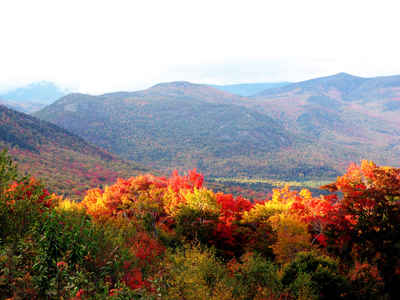New Hampshire State Emblem
Old Man of the Mountain

See Motto
Adopted in 1945.
The New Hampshire State Emblem was adopted in 1945.
The Old Man of the Mountain, also known as the Great Stone Face or the Profile, was a series of five granite cliff ledges on Cannon
Mountain in the White Mountains of New Hampshire, United States, that, when viewed from the north, appeared to be the jagged profile of a face. The
rock formation was 1,200 feet (370 m) above Profile Lake, and measured 40 feet (12 m) tall and 25 feet (7.6 m) wide. The site is located in the town
of Franconia.
The first recorded mention of the Old Man was in 1805. It collapsed on May 3, 2003
New Hampshire State Emblem:
Old Man of the Mountain

The formation was carved by glaciers and was first recorded as being discovered by a surveying team around 1805. The official state history says
several groups of surveyors were working in the Franconia Notch area at the time and claimed credit for the discovery.
The Old Man was famous largely because of statesman Daniel Webster, a New Hampshire native, who once wrote: "Men hang out their
signs indicative of their respective trades; shoe makers hang out a gigantic shoe; jewelers a monster watch, and the dentist hangs out a gold tooth;
but up in the Mountains of New Hampshire, God Almighty has hung out a sign to show that there He makes men."
The writer Nathaniel Hawthorne used the Old Man as inspiration for his short story "The Great Stone Face", published in 1850, in which he
described the formation as "a work of Nature in her mood of majestic playfulness".
The profile has been New Hampshire's state emblem since 1945. It was put on the state's license plate, state route signs, and on the back of New Hampshire's
Statehood Quarter, which is popularly promoted as the only US coin with a profile on both sides. Before the collapse, it could be seen from special
viewing areas along Interstate 93 in Franconia Notch State Park, approximately 80 miles (130 km) north of the state's capital, Concord.
New Hampshire Law
The law designating "Old Man of the Mountain" as the official New Hampshire state emblem is found in the New Hampshire Statutes, Title 1, Chapter 3, Section 3:1.
TITLE I
THE STATE AND ITS GOVERNMENT
CHAPTER 3
STATE EMBLEMS, FLAG, ETC.
Section 3:1
3:1 State Emblem. - The state emblem shall be of the following design: Within an elliptical panel, the longest dimension of which shall be vertical,
there shall appear an appropriate replica of the "Old Man of the Mountain;" surrounding the inner panel,
and enclosed within another ellipse, there shall be at the bottom of the design the words of any state motto which may be adopted by the general court;
and at the top of the design, between the inner and outer elliptical panels, the words, New Hampshire, appropriately separated from the motto, if adopted,
by one star on each side. Said emblem may be placed on all printed or related material issued by the state and its subdivisions relative to the development
of recreational, industrial, and agricultural resources of the state.
Source. 1945, 148:1. RSA 3:1. 1957, 107:1, eff. July 2, 1957.








